20 Feb 2012
Posted by Michelle in Expat Life, Language, Sweden | 1 comment
This is part one of my series in learning the Swedish language – Swedish classes in Sweden
SFI: Svenskundervisning för invandrare or Swedish for Immigrants
SFI is run by the Swedish government and is free. You are able to take the course if you have a Swedish person number and a residency permit. SFI offers daytime courses of between 15 to 20 hours a week and night courses of 6 hours a week. The night classes seem to be broken into 2 x 3 hours after work.
I have no personal experience with this course, and have heard mixed reviews from friends. Most have said the classes are well organised and taught however a few have likened their SFI experience to that of a circus. Still, considering the fact that it is free, I think it is worth signing up and hoping for the best. Class sizes are bigger than in the paid classes, which is to be expected, and SFI is offered throughout Sweden.
If you live in Stockholm, you can take the test at the SFI centre at Hornsgatan 124 (Zinkensdamm T-Bana):
Monday, Tuesday and Thursday at 10:30 am to 2:30 pm
Wednesday at 1:00 pm to 5:00 pm
Swedish for Academics (you can read about my experiences with SFEJ here)
The Swedish for academics course, and those for trained professionals are also offered by the government for free, and are around 30 hours of study per week. Classes are broken down by specialty, and a university degree, and for some reason, minimum English language are required for many of these courses. This is ideal for someone who can spare the 30 hours a week necessary to attend class, with presumably 10 hours or so of homework per week on top of that.
This course is broken down into:
Swedish for Educators (SFP)
Swedish for Engineers (SFINX)
Swedish for Economists, Lawyers, Social, Human Resources and Systems Specialists (SFEJ)
Swedish for Qualified Healthcare Workers (nurses, doctors, veterinarians, etc)
Swedish for Entrepreneurs
Swedish for Craftsmen (for example, carpenters, welders, and bricklayers)
Swedish for Truck Drivers
Swedish for Bus Drivers
I am going to be starting SFEJ in March, so you can follow me on my journey there. I am curious to see how I will 1) survive 30 hours of Swedish class a week and 2) How quickly my Swedish will improve.
To get into the course, I filled out the application form and sent it in with proof of my qualifications, my resume, proof of residency and so on. Then I was called in to take the Swedish exam, which consisted of a computer exam covering listening, reading and writing, and various chats with people working at SFI which seemed to result in a speaking grade. All in all, with waiting, being sent to the wrong person, being given the wrong exam to start with, doing the exam for the level after SFI and other running around, I was at the testing centre for about 5 hours. I hope your visit there goes a little more smoothly! Don’t forget to take a number when you arrive either, and bring along your passport for ID.
I am looking forward to the SFEJ course, and think it is pretty amazing that the government offers such a specialised course for free. Of course it is in any governments interest to help highly skilled migrants to quickly improve their Swedish skills and contribute to the economy, however many governments seem to forget this, and it is refreshing to see Sweden putting something into practice. As for the quality of the course, I don’t have an opinion yet, but i’ll be updating once I get started.
Folkuniversitetet
Folkuniversitetet is an adult education institute in Sweden and offers all sorts of courses, including Swedish language. It runs based on the Common European Framework of Reference for Languages, with A1 being an absolute beginner, (A1, A2, B1, B2, C1, C2), and C2 being at a near native equivalent. As the classes are a mix of nationalities, the course is obviously run in Swedish, even at the beginner levels, which is not as difficult or intimidating as it might sound.
Folkuniversitetet offers a range of courses, for example I have taken the 2 nights a week course in Uppsala which runs for around 5 weeks, as well as the monday to friday course, for two hours a day for a month. They also offer courses that focus entirely on conversation and other on grammar. These are paid courses, ranging from 2675 SEK for the 2×2 hours for 5 weeks course, and 4000SEK for the intensive course 5 days a week.
From personal experience, the quality of these courses depend entirely on the teacher you have, and I have been in both good and average courses. However, I have found in all 3 of the courses I have taken at the Folkuniversitetet that the teachers ask for feedback after a couple of lessons to make sure they focus on the areas we wish to improve – say more conversation. Class sizes are small – around 6 to 10 people, which gives plenty of opportunity for everyone to chat.
Quite a few people in my intensive course were just in Sweden for a month to take the course, before returning home to their job/studies, so this might be a good choice for you if you are only in Sweden short term, or want to pop over to improve your Swedish and enjoy the summer!
Medborgarskolan
Medborgarskolan is similar to Folkuniversitetet, an adult educational institution offering Swedish as a second language classes. They have translated the names of the courses into English as well, and offer intensive and normal courses.
University
Stockholm University offers a course for more advanced students for free. You can read more about it here. I’ve heard positive things about this course from a past student.
If you are an exchange/ERASMUS student, Swedish classes are often offered during your time in Sweden. At Uppsala University for example, you can read about classes here.
Universities and adult educational institutes in your home country might offer Swedish as well, so it is worth calling their language department and seeing if you can join. I studied Swedish at The University of Melbourne in Australia for a year before moving to Sweden, and it was a huge help in making me feel more at home when I arrived.
11 Feb 2012
Posted by Michelle in Expat Life, Sweden | 1 comment
I have now lived in Sweden for just over a year. I arrived in Uppsala last January to finish the last six months of my masters, then moving to Stockholm in August.

Quite a bit has changed since I first arrived – I am now volunteering at a fantastic organisation that helps the partners of people that have come to Stockholm to work with learning Swedish, finding work, understanding Swedish society, and very importantly, providing an instant social network and plenty of wonderful classes.
I am getting to work in my area of integration studies and immigration policy, and I am hoping this leads to some interesting opportunities this year. I have even been asked to give some speeches by a few organisations in the upcoming months, which is both scary and exciting.
Other things have changed as well – my Swedish has improved, but I am still reminded of how far I have to go when I listen to announcements on the train and can hardly understand a word of what is being said. My 30 hour a week Swedish course starting in March should help with this though.
The weather has been one of the most noticeable differences – Before we moved to Sweden I had been here about 7 or 8 times before to visit friends in both summer and winter, but nothing could prepare me for actually living here.
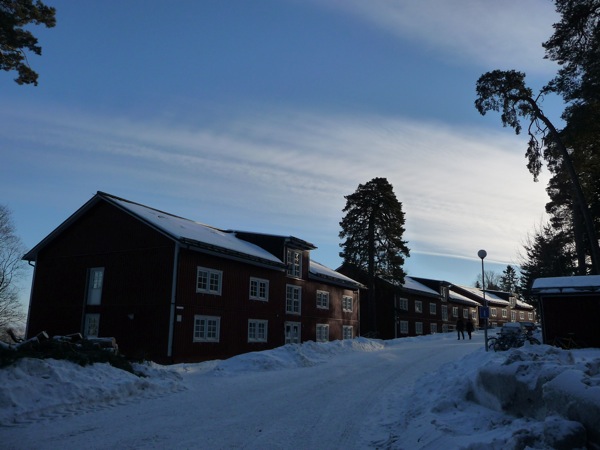
Despite working in London and barely seeing sunlight there for months on end, Sweden is in a totally different league. In January for example there is about 6 hours of sunlight a day (Compared to around 19 in June). Living in Uppsala, I rode my bike everywhere – to class, to do the shopping, to meet friends. Even when it was -20 degrees Celsius. I experienced the peculiar feeling of having my eyelashes freeze as I rode along and developed impressive multitasking skills of bike riding one handed in snow storms while shielding my eyes and attempting not to run over pedestrians while also not loosing my bag. Winter in Uppsala was beautiful and with so much exercise and socialising every day, I barely noticed the almost continual darkness. This year in Stockholm was a bit different. I take the tunnelbana everywhere and as I don’t live in the above cute red house filled with friendly students, I am not as social this year, which has led to me feeling quite a bit more tired. The gym seems to be helping, as does meeting friends a bit more regularly, but I still have a bit to learn above surviving the Swedish winter.
I have never seen such an amazing spring before living here. Our seasons in Australia are not as prominent, one melting softly into the other, and summer lasting seemingly forever. I remember cycling from our house in Uppsala along the river and through a park into town each day, and it seemed as though in the space of only a week, the landscape went from grey and white to the most amazing kaleidoscope of colour – the thick green grass shot up almost overnight, flowers started to appear and I couldn’t help smiling at the beauty of it all, and being amazed at how quickly it happened. I am also impressed with how much care the gardeners in Uppsala take, constantly planting new flowers after old ones have died, and even including flower boxes along bridges as you can see below.
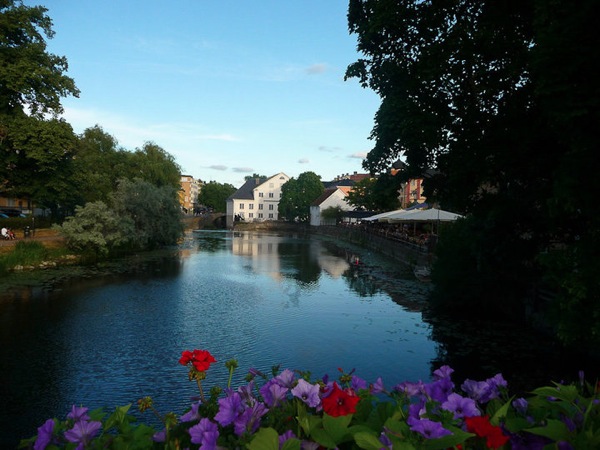
Summer in Sweden is a wonderful time, suddenly the parks are filled to the brim with people lying around reading, having picnics and grilling sausages, playing music and chatting. Little wooden stands start to appear though out town selling delicious punnets of fresh strawberries, blueberries and raspberries. Oh, and the sun almost never sets – I went for walks through the forest at 10 pm at night. The sun was up again at 2 or 3 am. In Australia I tended to avoid being outside in summer due to the ridiculious temperatures, not to mention the giant hole in the ozone layer and that fact that I have red hair and my people are not meant to live in tropical climates, but summer in Sweden is quite nice – not crazily hot.
If you do visit in summer, I can highly recommend visiting the Stockholm archipelago, with some islands only 30 minutes away. One friend of ours spent a week drifting from one island to the other, catching fish, camping and picking wild berries.
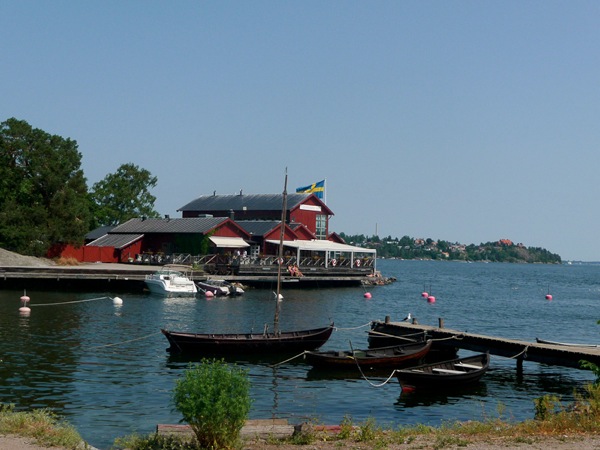
We have also moved 3 times in the last year, which seems to be below the average number of moves of people I know in Sweden. I’ll be posting some tips about renting an apartment in Stockholm shortly.
I have also learnt quite a bit of random information about life in Sweden in the last year – the medical system, how to get a person number, a bank account, an ID, how to renew your visa, study at a Swedish university and quite a bit more, but all of these things will be covered in their own posts.
I am not actually sure how long we will be living here, but as Geoff has just started a new job in December, it looks like we will be here for the foreseeable future. I am looking forward to seeing how life in Sweden is this time next year.
25 Jan 2012
Posted by Michelle in Travel | 0 comments
Nuremberg sounds like a fairly odd place to go on holidays. It brings to mind WWII, the Nuremberg trials, the Nazi rally grounds. But come Christmas time and Nuremberg is one of the best places on earth to be. It is alive with people in a festive mood, coming from all over to visit their legendary Christmas markets and to soak up the atmosphere.
By day, the old town was stunning in its traditional architecture.
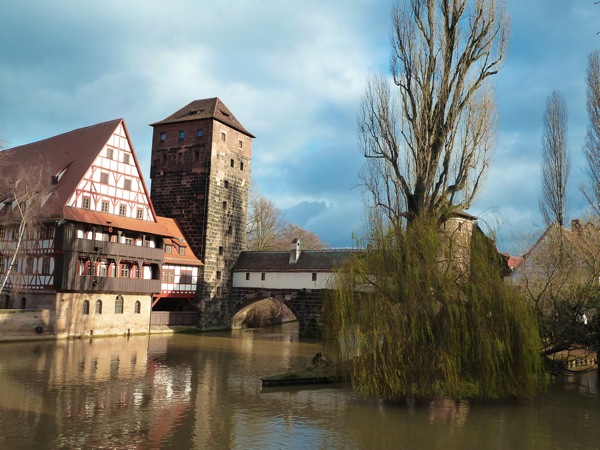
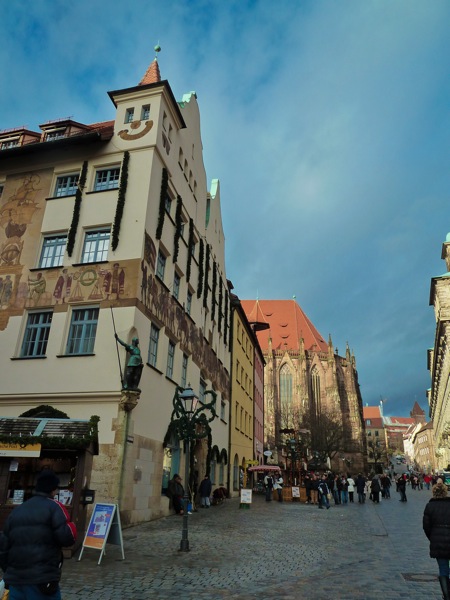
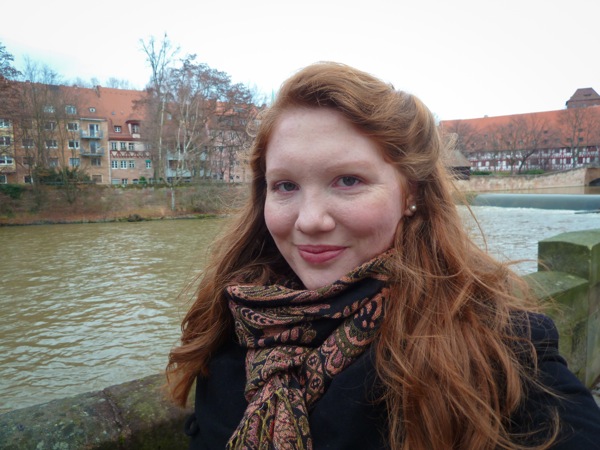
By night, it was on to the Christmas markets for some delicious Nürnberger bratwurst, gingerbread, and of course glühwein, and to enjoy the festive atmosphere. Unlike the Swedish Christmas markets, the Nuremberg markets were open nice and late, meaning you can meet friends there and enjoy a few drinks in the evening. Try coming on a week night if you want to avoid the crowds, as Saturday night was crazy, although with over a million visitors to the markets each year, they are normally pretty busy at the best of times (but that’s all part of the fun!).
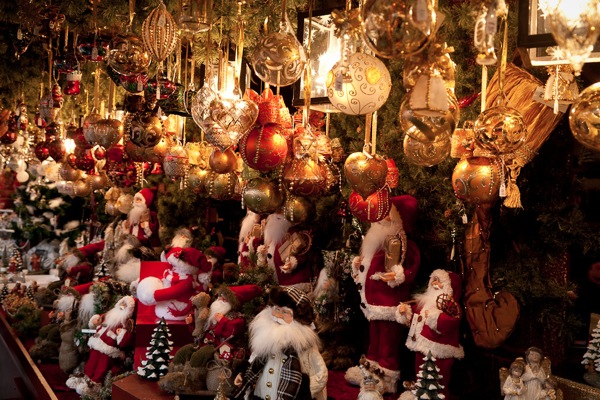
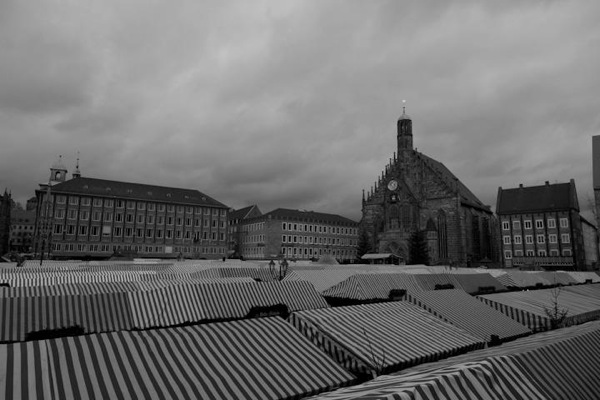
My favourite part of the trip? My best friend Marlene from Vienna and her lovely boyfriend Andy turning up in Nuremberg to surprise me! There I was at the Christmas markets one night, enjoying some delicious Nuremberg sausages, with a suspiciously excited Geoff, when he points over in the distance ‘Oh, isn’t that Marlene? What on earth is she doing here?’ he exclaimed mischievously. I was speechless. It was so wonderful to see her and Andy again after almost a year. It turned out she and Geoff had been organising this for a few months. I need to get some spy skills!
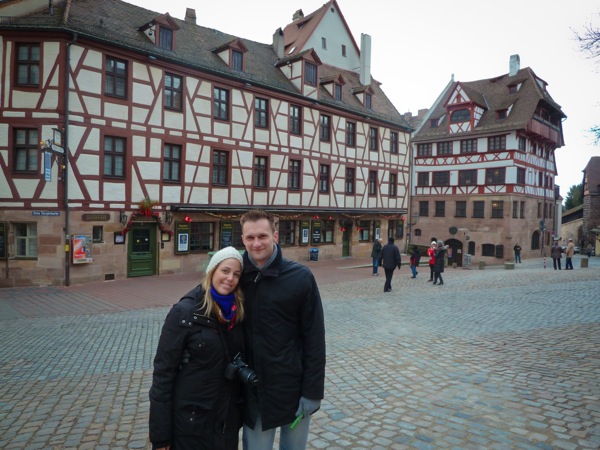 Yes, we took a ride, and it was great! Being a tourist is lovely.
Yes, we took a ride, and it was great! Being a tourist is lovely.
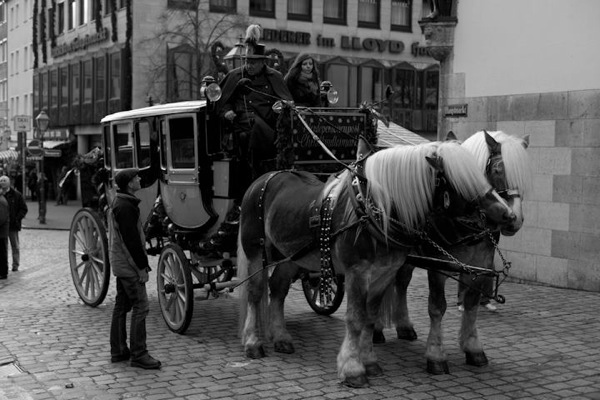
The imperial castle was beautiful,and worth the hike up the hill to enjoy the views over Nuremberg.
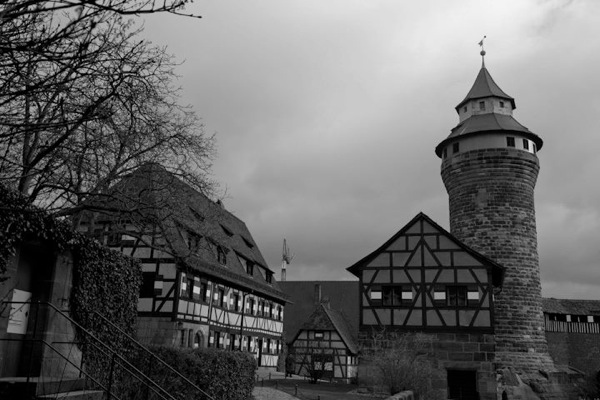
One of the prettiest streets I have seen. I’d love to sit out there in the summer with a glass of wine.
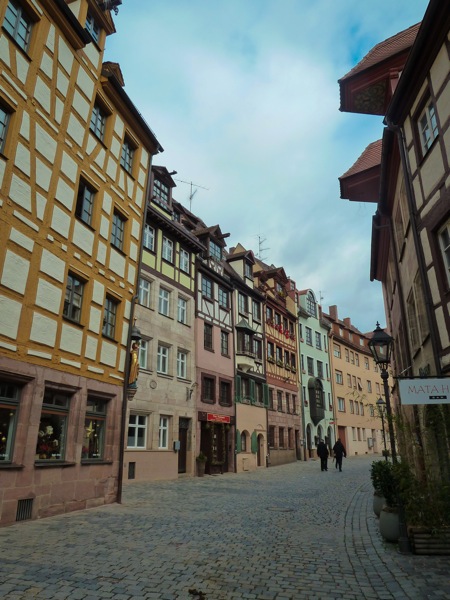
Our trip to Nuremberg was wonderful, and I can’t wait to go back another (this?) year, to visit the Christmas markets again… and in summer… and maybe autumn…
20 Dec 2011
Posted by Michelle in Recipes | 1 comment
Time for a delicious Christmassy recipe. This time, the very Dutch krestkrans, filled with with almond paste and enveloped in puff pastry, the recipe given to me by my wonderful grandmother (although to be honest, whenever she made this she just threw things in without a strict recipe). This can be fashioned into a wreath, as seen here, or simply into straight lines.
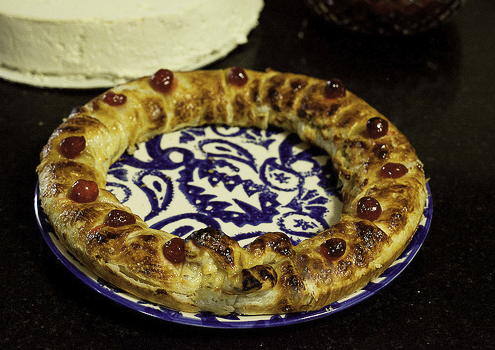
Ingredients:
For the almond filling:
The earlier you can prepare the almond filling, the better. We prepared ours a month before making the kestkrans and stored it in the fridge.
350g of peeled and blanched almonds. (I remember my grandmother employing me as a child having to peel the almonds by hand. Luckily you can now buy them already peeled)
150g caster sugar
The rind of 1 lemon
1 egg
Grind the almonds in a food processor and combine with the egg and lemon rind. Store this in a jar in the fridge and resist temptation to sample before Christmas.
For the pastry:
I used shop bought puff pastry, but you can always make this yourself should you feel so inclined.
Decorations:
Apricot jam
Glacé cherries
Then:
On kestkrans day, take your almond paste from the fridge and taste a little to help inspire you, then remove the rest from the jar and kneed it a little. You can always add a little water if it is a bit dry.
Preheat the oven to 220 degrees Celsius.
After bushing the pan with some melted butter, cut the puff pastry and line the pan with it, adding a filling of almond paste, and then covering with the remaining puff pastry.
Then it is time to glaze the wreath with a combination of apricot jam heated over the stove for a few minutes with a little water:
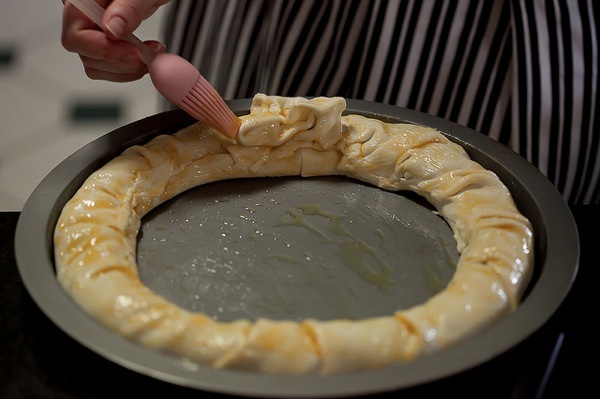
And then add the cherries:
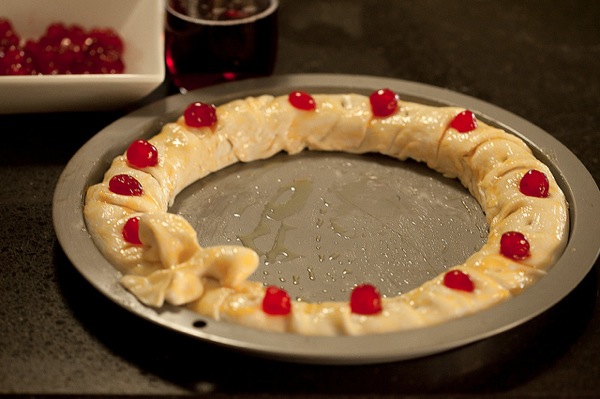
Bake in the oven for 20 to 25 minutes, until nicely puffed and a beautiful golden colour.
Let cool a little and then cut into little pieces and enjoy! The perfect start to Christmas.
15 Dec 2011
Posted by Michelle in Expat Life, Sweden | 0 comments
The last couple of weeks have been a bit hard. I have been going to Swedish class each morning, and doing my Swedish homework in the afternoons, but apart from that, my motivation levels have been quite low and I have felt completely exhausted. This might have something to do with the fact that we currently have about 2.5 hours of sunlight per day, and even this has been thwarted by heavy cloud cover and rain. When I moved to Sweden in January I was not bothered at all by the darkness, and I enjoy winter normally, so I have no idea what the problem has been lately.
I bought a cute Swedish Christmas light to brighten up the apartment. If you are in Sweden at Christmas time, you will see little arrows of light in almost every window from one of these.
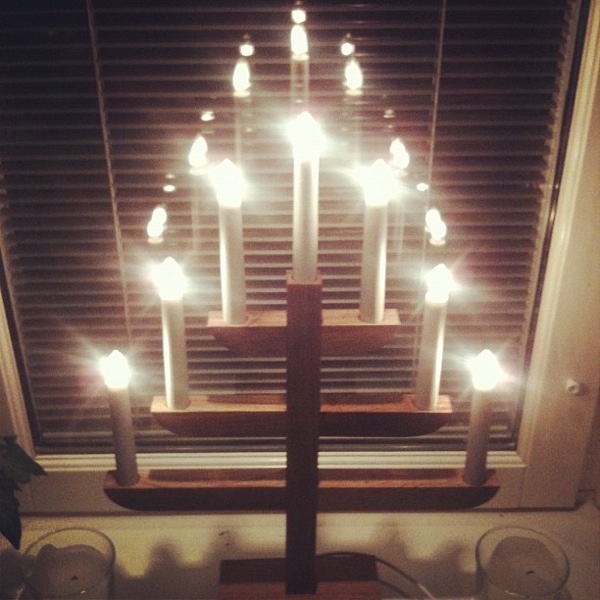
Miraculously, over the last couple of days I have began to get my enthusiasm back. I have done more things this week, than I have in the last two weeks combined, and it feels really good. I am starting to work out what I need to focus on next year to be able to get where I want to get – career wise and so on. Now that I have a personnummer I am able to apply to take the Swedish for academics course next year, which is an intensive course broken down by study specialisations, run by the Swedish government – with the added bonus of being free. I need to submit more proof of my past studies than I do for any of the PhD applications I am working on, but I think it will be worth it if I am accepted.
I also had a great day today catching up with an old friend from Melbourne who stopped by Sweden on his way to moving to Seattle. We walked for hours all over Stockholm, visited Skansen and relaxed in cafes. The sun even came out – Jerome must have brought it with him from Australia.
My main excitement this week is that Geoff and I are off to Nuremberg in Germany tomorrow, and I can’t wait. This will combine many of my favourite things, Christmas markets, world war two history, and of course, spending time with Geoff. We will also be visiting Prague for a few days as well, and I am sure it will be amazing.
So god jul, and have a wonderful Christmas time, be it in sunny Australia or in (hopefully) snowy Europe – and everywhere in between!













 Yes, we took a ride, and it was great! Being a tourist is lovely.
Yes, we took a ride, and it was great! Being a tourist is lovely.












